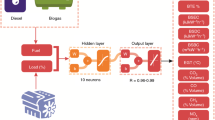Abstract
Engine performance varies significantly due to the variations in weather conditions in different regions. So, in order to optimize the performance and fuel consumption, engines should be calibrated according to the weather conditions in which they operate. In this paper the effects of the air conditions (such as pressure and temperature) on the power and fuel consumption of the SI engine are modeled. First a comprehensive one-dimensional model of the real engine is constructed in GT POWER®, and validated with experimental data from actual engine. Next, using this model, a set of experiments is carried out by varying pressure, temperature, and humidity of the incoming air, and engine speed. The measuring outputs are the power and BSFC of the engine. Then, two mathematical models are developed using MLP Neural Networks and also regression technique to estimate the outputs in terms of the inputs. At last, the estimation ability of the models is shown by a set of new experiments. These models could be used in engine calibration and shift the process from a near blind one to the one in which prior information have a significant role.







Similar content being viewed by others
Notes
Computer experiment.
Abbreviations
- u :
-
Input variable
- p :
-
Pressure
- T :
-
Temperature
- Wi :
-
Weight of ith layer
- Wij :
-
Neuron weight corresponding to jth input
- b i :
-
Bias of the ith neuron
- b :
-
Network bias
- BSFC:
-
Brake Specific Fuel Consumption
- RPM:
-
Engine speed
- SI:
-
Spark ignition
- a0, a1, a2, b0, b1, b2, c0, c1, c2, d0, d1, d2 :
-
Constants coefficient
- rms:
-
Root mean square
- x :
-
Real value
- \(\hat{x}\) :
-
Predicted value
- N :
-
Number of data samples
- Pw :
-
Power
- IC :
-
Internal combustion
- φ :
-
Activation function
- n :
-
Number of neurons in hidden layer
- 0:
-
Based amount
References
Buhler G, Jochem P (2008) CO2 emission reduction in freight transports: how to stimulate environmental friendly behaviour? ZEW Centre for Euro Econ Res Disc, Paper No. 08-066
Chiu CP, Horng RF (1992) Effects of intake air temperature and residual gas concentration on cycle-to-cycle combustion variation in a two-stroke cycle S.I. engine equipped with an air—assisted fuel injection system. JSME Int J 37:957–965
Cumming S (1993) Neural networks for monitoring of engine condition data. Neural Comput Appl 1:96–102
Golcu M, Sekmen Y, Erduranli P, Salman MS (2005) Artificial neural-network based modeling of variable valve-timing in a spark-ignition engine. Appl Energy 81:187–197
Harari R, Sher E (1993) The Effect of ambient pressure on the performance map of a two-stroke SI engine. 930503, SAE International Congress and Exposition, Detroit, MI, pp 115–123
Hatami M, Ganji DD, Gorji-Bandpy M (2015) Experimental and numerical analysis of the optimized finned-tube heat exchanger for OM314 diesel exhaust energy recovery. Energy Conv Manag 97:26–41
Hatami M, Ganji DD, Gorji-Bandpy M (2015) Experimental and thermodynamical analyses of the diesel exhaust vortex generator heat exchanger for optimizing its operating condition. App Therm Eng 75:580–591
Heywood JB (1989) Internal combustion engine fundamentals. McGraw-Hill Book Corporation
Ketelaer T, Kaschub T, Jochem P, Fichtner W (2014) The potential of carbon dioxide emission reductions in German commercial transport by electric vehicles. Int J Env Sci Tech 11:2169–2184
Li XQ, Yurkovich S (2000) Neural network based, discrete adaptive sliding mode control for idle speed regulation in IC engines. J of Dyn Sys Measur Cont Trans ASME 122:269–275
Mckay MD, Beckman RJ, Conover WJ (1979) A comparison of three methods of selecting values of input variables in the analysis of output from a computer code. Thechnometrics 31:239–245
Mosayebidorcheh, Hatami M, Mosayebidorcheh T, Ganji DD (2015) Optimization analysis of convective–radiative longitudinal fins with temperature-dependent properties and different section shapes and materials. Energy Conv Manag 106:1286–1294
Nelles O (2001) Nonlinear system identification: from classical approaches to neural networks and fuzzy models. Springer-Verlag
Pourmehran O, Rahimi-Gorji M, Hatami M, Sahebi SSR, Domairry G (2015) Numerical optimization of microchannel heat sink (MCHS) performance cooled by KKL based nanofluids in saturated porous medium. J Taiwan Ins Chem Eng 55:49–68
Pulkrabek WW (1997) Engineering fundamentals of the internal combustion engine. Prentice Hall, Inc
Rahimi-Gorji M, Pourmehran O, Hatami M, Ganji DD (2015) Statistical optimization of microchannel heat sink (MCHS) geometry cooled by different nanofluids using RSM analysis. Eur Phys J Plus 130:1–21
Saltelli A, Chan K, Scott EM (2000) Sensitivity analysis. Wiley
Schmick PJ (2011) Effect of atmospheric pressure and temperature on small spark ignition internal combustion engine’s performance. MSc. Thesis in Aeronautical Engineering, Air Force Institute of Technology, Air University
Sodré JR, Soares SMC (2003) Comparison of engine power correction factors for varying atmospheric conditions. J Braz Soc Mech Sci Eng XXV(3):279–285
Tasdemir S, Saritas I, Ciniviz M, Allahverdi N (2011) Artificial neural network and fuzzy expert system comparison for prediction of performance and emission parameters on a gasoline engine. Expert Syst Appl 38:13912–13923
Taylor CF (1997) The internal combustion engine in theory and practice. MIT Press
Vong CM, Wong PK, Li YP (2006) Prediction of automotive engine power and torque using least squares support vector machines and Bayesian inference. Eng Applic Artif Intel 19:277–287
Watanabe I, Kuroda H (1981) Effect of atmospheric temperature on the power output of a two-stroke cycle crankcase compression gasoline engine. SAE Exposition, Detroit
Author information
Authors and Affiliations
Corresponding author
Additional information
Technical Editor: Luis Fernando Figueira da Silva.
Appendix
Rights and permissions
About this article
Cite this article
Rahimi-Gorji, M., Ghajar, M., Kakaee, AH. et al. Modeling of the air conditions effects on the power and fuel consumption of the SI engine using neural networks and regression. J Braz. Soc. Mech. Sci. Eng. 39, 375–384 (2017). https://doi.org/10.1007/s40430-016-0539-1
Received:
Accepted:
Published:
Issue Date:
DOI: https://doi.org/10.1007/s40430-016-0539-1




